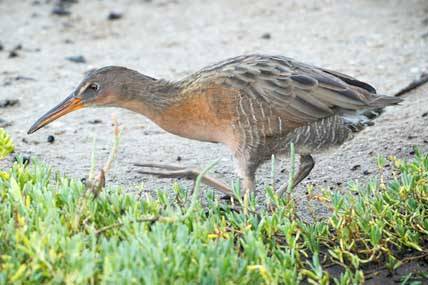In 1903, President Theodore Roosevelt established Pelican Island, off the coast of Florida, as the first federal refuge. This put migratory bird conservation as a pivotal factor in the National Wildlife Refuge System we know today.
Before starting work at the Kenai National Wildlife Refuge, I was fortunate enough to be accepted into an internship program at the San Diego National Wildlife Refuge Complex. Both of these refuges are situated along the Pacific Flyway and are used as stopover sites by migratory birds, where they rest and refuel on their long flights.
The San Diego refuge complex was established in 1972. This complex is made up of four units. Three are coastal — Tijuana Slough, Seal Beach and San Diego Bay refuges. The San Diego refuge is inland.
Almost 18,000 acres of habitats are conserved, ranging from the inland chaparral to the coastal sage scrub, saltwater marsh and open waters of the bay. Together these protected green spaces are interwoven in and around the city of San Diego, home to more than 3 million people, making the complex the true definition of an urban refuge.
In San Diego, the sprawling city surely would have overtaken these areas had they not been protected. Only 22 percent of San Diego Bay’s historic salt marsh and 8 percent of its original intertidal habitats remain intact. Today, the San Diego refuge complex provides critical habitats for the Quino checkerspot butterfly, salt marsh bird’s beak, light-footed Ridgway’s rail and Belding’s Savannah sparrow, all species threatened by extinction.
Much closer to home, the Kenai refuge was originally established as the Kenai National Moose Range back in 1941. Just shy of 2 million acres, you can be up in alpine tundra with opportunities to see Dall sheep, mountain goats, caribou and ptarmigan. Or you can be down in boreal forest and wetlands, setting your eyes on moose, bear, lynx and spruce grouse.
Mostly to the west of the refuge, along Cook Inlet, reside 50,000 people spread out in communities and rural subdivisions from Point Possession to East End Road. Compared to other vast refuges in Alaska, there is much greater access for the half million visitors who travel here, mostly in the 1.4 million vehicles that navigate the Sterling Highway each year. The argument could be made that Kenai refuge is Alaska’s version of an urban refuge.
These two “urban” refuges actively manage both habitats and species in their efforts to conserve their natural landscapes. Here on the Kenai refuge, we use prescribed fire and mechanical treatments to create fuel breaks.
We oversee 14,000 acres of commercial oil and gas leases as well as the restoration of pads no longer in operation. We work with our partners to construct passages under roadways to ensure safe travel for both wildlife and fish. We manage invasive plants.
At San Diego Bay refuge, they have restored solar salt ponds, created by a large-scale salt production facility, back into a flourishing salt marsh. Cleanup projects are under way in contaminated areas left behind by manufacturing shops, slaughterhouses, railroad offices and burn ash that was disposed into marshes before it was a refuge. They, too, manage invasive plants.
With the conservation of these lands as refuges, not only have flora and fauna benefited, but people truly experience nature as well. Both refuges built visitor centers so residents and visitors can learn about these natural systems, and trails were constructed to help take them (and you) there.
Whether out trying to catch a glimpse of a rare bird, going on a hunt, or taking the camera out for that breathtaking shot, both refuges provide the opportunity to engage in the wild communities that abound.
With these two refuges sitting along the Pacific Flyway, you can imagine that some birds even migrate between the two refuges. An orange-crowned warbler, banded by Kenai refuge biologist Todd Eskelin on Lower Russian Lake, showed up just north of the San Diego refuge complex in 2000.
When reflecting on my short time at the San Diego and Kenai refuges, I come away with a greater understanding that these are but two of more than 560 refuges within the National Wildlife Refuge System. I’ve seen firsthand how the mission of the refuge system, “to administer a national network of lands and waters for the conservation, management, and where appropriate, restoration of the fish, wildlife, and plant resources and their habitats for the benefit of present and future generations of Americans,” plays out in these two refuges, 2,500 miles apart, on the Pacific Flyway.
Colin Canterbury is a seasonal biological technician at Kenai National Wildlife Refuge. Find more Refuge Notebook articles (1999-present) at https://www.fws.gov/Refuge/Kenai/community/Refuge_notebook.html.

